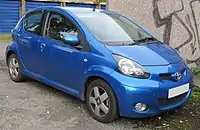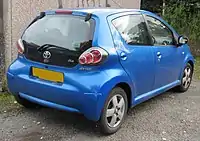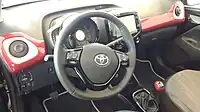| Toyota Aygo | |
|---|---|
.jpg.webp) Toyota Aygo (KGB40) | |
| Overview | |
| Manufacturer | Toyota |
| Production | February 2005 – 2022 |
| Assembly | Czech Republic: Kolín (TPCA/TMMCZ) |
| Body and chassis | |
| Class | City car (A) |
| Body style | 3/5-door hatchback |
| Layout | Front-engine, front-wheel-drive |
| Related | Citroën C1 (2005–2022) Peugeot 107 (2005–2014) Peugeot 108 (2014–2021) |
| Chronology | |
| Successor | Toyota Aygo X Toyota Agya (South Africa)[1][2][3] |
The Toyota Aygo is a city car (A-segment) marketed by Toyota mainly in the European market between 2005 and 2022 across two generations. The Aygo was first displayed at the 2005 Geneva International Motor Show. It was built alongside the related Citroën C1 and Peugeot 107/108 at the Toyota Peugeot Citroën Automobile Czech (TPCA) joint venture in Kolín, Czech Republic. The Aygo's production ended in 2021 and the model was replaced by the crossover-styled Aygo X.
The name "Aygo" comes from "i-go", symbolising freedom and mobility.[4]
First generation (AB10/AB20/AB30; 2005)
| First generation (AB10/AB20/AB30) | |
|---|---|
 | |
| Overview | |
| Also called | Peugeot 107 Citroën C1 |
| Production | February 2005 – 2014 |
| Powertrain | |
| Engine | 1.0 L 1KR-FE I3 (petrol; KGB10) 1.4 L DV4-TD I4 (diesel; WNB10) |
| Dimensions | |
| Wheelbase | 2,340 mm (92.1 in) |
| Length | 3,405 mm (134.1 in) |
| Width | 1,615 mm (63.6 in) |
| Height | 1,465 mm (57.7 in) |
| Curb weight | 890 kg (1,962 lb) |
The decision to produce the cars was made on 12 July 2001 when the presidents of Toyota and PSA Peugeot Citroën, Fujio Cho and Jean-Martin Folz respectively, decided to produce a small car to share development costs. This project was called B-Zero. The Peugeot 107 and Citroën C1 are rebadged versions of the same car.

The main difference between the Aygo and its French siblings are badging, rear side windows, steering wheel, and the easily recognizable front and rear treatments. The planned production was 300,000 cars annually – 100,000 cars per brand. Sales began in July 2005, and the car was available as a three- or five-door hatchback. There were two engines available, a 1.0-litre, three-cylinder engine rated at 68 PS (50 kW), and a 1.4 L HDi Diesel I4 engine rated at 54 PS (40 kW).
The Aygo was used on BBC's Top Gear in a giant match of football, showcasing its maneuverability. The Top Gear presenters deemed the Aygo and its Peugeot and Citroën counterparts to be competent town cars.
A modified Aygo was also used on Fifth Gear to perform a twelve metre high loop the loop on a specially-designed track to determine if a stunt that can be done using Hot Wheels toys can be replicated in real life. The stunt was driven by stuntman Steve Truglia in May 2009.
In January 2010, the Aygo was part of a worldwide recall by Toyota for a faulty sticking accelerator pedal. It was found that under some circumstances, the pedal could stick in a partially depressed position, or return slowly to the off position. The recall affected the Aygo, Peugeot 107 and Citroën C1 models built between February 2005 and August 2009.[5] Information from Toyota later suggested, however, that only Aygos with automatic gearboxes were affected, and that those with manual gearboxes were not.[6]
2009–2012 (AB20)
The Aygo received its first facelift, replacing the front bumper shape from the original, and changing the rear lights to a transparent appearance, from their original red tinted cluster.
 2010 Toyota Aygo facelift
2010 Toyota Aygo facelift 2010 Toyota Aygo facelift
2010 Toyota Aygo facelift
2012–2014 (AB30)
The Aygo received its second facelift, this time incorporating a much more angular bumper, and space for the inclusion of daytime running lights (DRL).[7]
_%E2%80%93_Frontansicht%252C_10._M%C3%A4rz_2012%252C_Ratingen.jpg.webp) 2012 Toyota Aygo facelift
2012 Toyota Aygo facelift_%E2%80%93_Heckansicht%252C_10._M%C3%A4rz_2012%252C_Ratingen.jpg.webp) 2012 Toyota Aygo facelift
2012 Toyota Aygo facelift
Reliability
Breakdown statistics reported by the German Automobile Club in May 2010 placed the Aygo (which the data grouped with the Citroën C1 and Peugeot 107) at the top of the sub small car class, in respect of the low breakdown rates achieved for cars aged between one and four years.[8][9]
Engines
| Model | Year | Engine | Displacement | Power | Torque | 0–100 km/h (0–62 mph) |
Top speed | CO2 emission (g/km) |
|---|---|---|---|---|---|---|---|---|
| 1.0i 12V | 2005–2014 | I3 | 998 cc | 68 PS (50 kW; 67 hp) at 6,000 rpm | 93 N⋅m (69 lbf⋅ft) at 3,600 rpm | 14.2 s | 158 km/h (98 mph) | 106[10] |
| Model | Year | Engine | Displacement | Power | Torque | 0–100 km/h (0–62 mph) |
Top speed | CO2 emission (g/km) |
|---|---|---|---|---|---|---|---|---|
| 1.4 HDi 8V | 2005–2007 | I4 | 1398 cc | 55 PS (40 kW; 54 hp) at 4,000 rpm | 130 N⋅m (96 lbf⋅ft) at 1,750 rpm | 15.6 s | 154 km/h (96 mph) | 109 |
Safety
"Aygo Crazy" concept

.jpg.webp)
In 2008, Toyota created a driveable one off concept car based on the Toyota Aygo. Named the Aygo Crazy, it was unveiled to the public at the July 2008 British International Motor Show in London, before appearing at other motor shows that year based in the United Kingdom.[13]
The Aygo Crazy has a mid mounted 1.8 litre VVTL-i engine from the Toyota MR2 and Celica, mated to an MR2 five speed gearbox and fitted with a Toyota Motorsport turbocharger conversion. The manufacturer claims the engine produces 147 kW (197 bhp) at 6,700 rpm and 240 N⋅m (177 lb⋅ft) torque at 3,400 rpm.
Weighing just 1,050 kg (2,315 lb), this gives it a 0–100 km/h (0–62 mph) sprint time of 5.75 seconds and a theoretical top speed of 204 km/h (127 mph), though the latter has not been tested. Unlike the standard Aygo, it has no driver aids, power steering or anti lock brakes but its rear wheel drive layout helps traction under heavy acceleration.
Exterior modifications include wider arches to accommodate the one inch of extra track, 17 inch alloy wheels with Goodyear tyres and a carbon fibre rear spoiler designed for the 322 km/h (200 mph) American Champ Car series.
Suspension is from the MR2, with adjustable Tein shock absorbers and MacPherson struts front and rear. To cope with the extra power, Toyota upgraded the standard 247 mm (9.7 in) front brake discs to a 328 mm (12.9 in) Brembo conversion, with 280 mm (11.0 in) ventilated rear discs replacing the 200 mm (7.9 in) drums normally found on the Aygo. An uprated Helix clutch is also used.
The interior features a partial roll cage for extra chassis comfort and driver protection. Two specially designed sports seats, trimmed in red and black, and a suede rimmed Sparco steering wheel complete the race-inspired look.
Toyota claims the Aygo Crazy cost £100,000 to build.[14]
BYD F0
Since 2008, the Chinese car manufacturer BYD Auto has produced the BYD F0, an unlicensed clone of the Toyota Aygo.[15]

Second generation (AB40; 2014)
| Second generation (AB40) | |
|---|---|
_%E2%80%93_Frontansicht%252C_18._Oktober_2015%252C_D%C3%BCsseldorf.jpg.webp) | |
| Overview | |
| Also called | Peugeot 108 Citroën C1 |
| Production | May 2014 – 2022 |
| Powertrain | |
| Engine | 1.0 L 1KR-FE I3 (petrol) (2014-2018) 1.0 L 1KR-B52 I3 (petrol) (2018-2021) |
| Dimensions | |
| Wheelbase | 2,340 mm (92.1 in) |
| Length | 3,455 mm (136.0 in) |
| Width | 1,615 mm (63.6 in) |
| Height | 1,460 mm (57.5 in) |
_%E2%80%93_Heckansicht%252C_18._Oktober_2015%252C_D%C3%BCsseldorf.jpg.webp)
Toyota revealed a completely redesigned Aygo at the March 2014 Geneva International Motor Show with the slogan 'go fun yourself'. The design was attributed to Japanese youth culture, inspired by Japanese manga robot Astro Boy and an egg in a box and has aims to make the Aygo more accessible to younger drivers, and allow for a greater level of customisability.[16][17] It began rolling off the production line on 27 May 2014.
Models include:
- Aygo x – base model, with electric front windows, wing mirrors and daytime running lights
- Aygo x-play – in addition to 'x' – manual AC, Bluetooth connectivity and steering wheel controls
- Aygo x-pression – in addition to 'x-play' – 15-inch silver alloys, part leather seats, 'x-touch' seven-inch multimedia system, DAB+ radio, front fog lights and rear view reversing camera
- Aygo x-cite – (special edition) – in addition to 'x-pression' – 15-inch gloss black alloys and optional 'x-nav'
- Aygo x-clusiv – (special edition) – in addition to 'x-pression' – 15-inch machined alloys, climate control AC, optional 'x-nav' and smart entry and start
- Aygo x-pure – (special edition) – in addition to 'x-pression' - (minus the part leather seats) comes in Pure White colour with silver trim 'X' and back bumper, white machined alloys and privacy glass in the back.
The Aygo also includes numerous safety features such as vehicle stability control (VSC), anti lock braking system (ABS), hill start assist control (HAC) and supplemental restraint system (SRS) with six airbags.[18]
2018–2021
The refreshed second generation Aygo was unveiled at the March 2018 Geneva International Motor Show. and features a new front bumper, headlights, tail lights and engine.[19]
 Front (facelift; UK)
Front (facelift; UK) Rear (facelift; UK)
Rear (facelift; UK) Interior
Interior
Powertrain
| Model | Years | Engine type | Displacement | Power | Torque | 0–100 km/h (0–62 mph) | Top speed | Drive |
|---|---|---|---|---|---|---|---|---|
| 1.0 VVT-i | 2014-2018 | 1.0 L 1KR-FE I3 | 998 cc (60.9 cu in; 1.0 L) | 68 hp (69 PS; 51 kW) @ 6000 | 95 N⋅m (70 lb⋅ft) @ 4300 | 14.2 s | 160 km/h (99 mph) | FWD |
| 1.0 VVT-i | 2019-2022 | 1.0 L 1KR-B52 I3 | 998 cc (60.9 cu in; 1.0 L) | 71 hp (72 PS; 53 kW) @ 6000 | 93 N⋅m (69 lb⋅ft) @ 4400 | 14.1 s | FWD | |
Sales
| Year | Europe[lower-roman 1][20] |
|---|---|
| 2005 | 21,360 |
| 2006 | 96,251 |
| 2007 | 102,671 |
| 2008 | 101,303 |
| 2009 | 103,252 |
| 2010 | 83,063 |
| 2011 | 88,477 |
| 2012 | 72,295 |
| 2013 | 63,993 |
| 2014 | 68,874 |
| 2015 | 86,085 |
| 2016 | 84,321 |
| 2017 | 84,588 |
| 2018 | 92,187 |
| 2019 | 99,510 |
| 2020 | 82,711 |
| 2021 | 82,820 |
| 2022 | 9,646 |
- ↑ Europe: 2020 EU 27 + UK + Switzerland + Norway + Iceland
References
- ↑ "Toyota's new Tazz". Cars.co.za. South Africa. 12 November 2020. Retrieved 6 February 2021.
- ↑ Parker, Sean (24 November 2020). "We drive Toyota's cheapest new small car, the Agya". Wheels 24. South Africa. Retrieved 6 February 2021.
- ↑ Woosey, Jason (25 November 2020). "Agya arrives as Toyota's cheapest new car: SA prices announced". IOL. South Africa. Retrieved 7 February 2021.
- ↑ The New Toyota Aygo, UK: Car pages
- ↑ "– Peugeot follows Toyota in Car Recall". BBC News. 30 January 2010. Retrieved 25 May 2012.
- ↑ "Toyota UK Accelerator Pedal Recall". Archived from the original on 11 June 2010. Retrieved 9 February 2010.
- ↑ – 2014 Toyota Aygo Release, UK: Toyota References, 10 January 2014, retrieved 23 May 2014
- ↑ "Die ADAC Pannenstatistik 2009". ADAC Motorwelt: 26–27. May 2010.
- ↑ "Pannenstatistik – Kleinstwagen" [Breakdown statistics – Microcars] (in German). ADAC. May 2010. Archived from the original on 2 May 2010.
- ↑ Abuelsamid, Sam (1 February 2009). "2009 Toyota Aygo drops CO2 emissions to 106 g/km". Autoblog. Retrieved 1 February 2016.
- ↑ "Official Citroen C1 2005 safety rating". Euro NCAP.
- ↑ "Official Toyota Aygo 2012 safety rating results". Euro NCAP.
- ↑ "Toyota reveals Aygo supercar concept". AM-online. UK. 13 June 2008. Retrieved 25 May 2012.
- ↑ "Toyota Aygo Crazy review". Autocar. UK. 9 June 2008. Retrieved 25 May 2012.
- ↑ Bonnet, Oliver (1 October 2009). "Voitures chinoises : l'art du copier-coller". L'Internaute (in French). Retrieved 5 November 2021.
- ↑ Philip, Sam (3 March 2014). "It's the new Toyota Aygo. No, really". Top Gear. Archived from the original on 4 June 2015. Retrieved 1 May 2015.
- ↑ "All-new Toyota AYGO revealed" (Press release). UK: Toyota. Retrieved 11 February 2015.
- ↑ "New Toyota Aygo new x-cite Models". Top Car News. Archived from the original on 21 January 2018. Retrieved 27 June 2017.
- ↑ "NEW AYGO – The success story continues with a fresh face and more driving fun than ever" (Press release). Europe: Toyota. 23 February 2018. Retrieved 1 March 2018.
- ↑ "Toyota Aygo European sales figures". carsalesbase.com. 31 January 2014. Retrieved 14 December 2020.